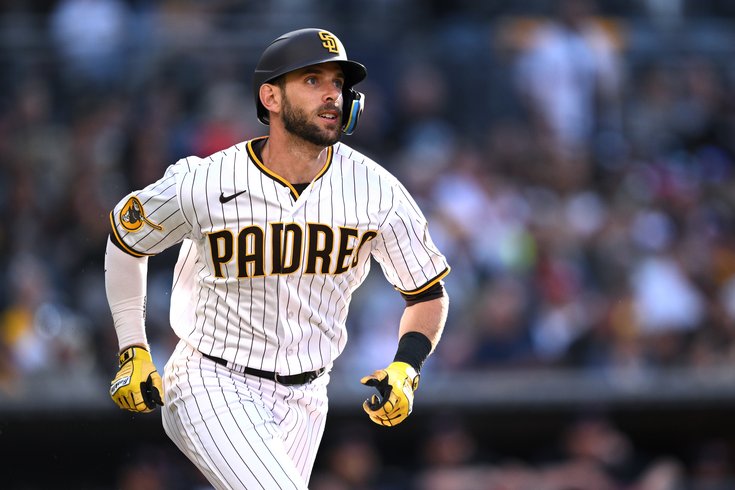
September 06, 2023
 Orlando Ramirez/USA TODAY Sports
Orlando Ramirez/USA TODAY Sports
San Diego Padres catcher Austin Nola has been diagnosed with oculomotor dysfunction, a condition that the impairs the brain's ability to coordinate eye movements. He was struck by a pitch in March that left him with lingering vision issues.
The sibling rivalry between Phillies pitcher Aaron Nola and his older brother, Austin, has been absent from the Phils' games against the San Diego Padres this summer. That's partly because Austin is not currently on the Padres' roster.
Austin Nola was struck by a pitch in spring training on March 19 and suffered a broken nose. The 33-year-old catcher returned to action days later, but got off to dismal start to the baseball season. He complained of lingering vision problems and trouble tracking the ball. As Nola's season unraveled, the Padres demoted him to the minor leagues in August to give him a chance to regain his form.
Nola recently told the San Diego Tribune that he chose to step away from his minor league assignment to undergo neurological and vision tests. He was prompted by the news that Yankees player Anthony Rizzo had recently been diagnosed with post-concussion syndrome. Rizzo's symptoms sounded similar to his.
"I just couldn't figure it out," Nola said. "I just didn't know why I wasn't seeing the ball."
Rizzo had complained of persistent vision problems, brain fog and slow reaction times in the months after he collided with Padres star Fernando Tatis Jr. during a game on May 28. The Yankees placed Rizzo on the injured list on Aug. 3, explaining that his problems appeared to stem from an undiagnosed concussion.
After consulting with specialists, Nola was diagnosed with oculomotor dysfunction, a condition that the impairs the brain's ability to coordinate eye movements. Common symptoms include headaches, eye strain, difficulty reading and problems with following and tracking objects.
Although Nola had not been diagnosed with a concussion back in March, the medical tests he recently took indicated that has been suffering from the cascading effects that often follow traumatic brain injuries. When a blow to the head jostles the brain, it can disrupt the connections between neurons that coordinate the senses and cognitive processing, including the ability to focus.
About two-thirds of those connections are involved in the visual system, which explains why many people who suffer concussions end up with vision problems, according to the Concussion Alliance.
For many years, the recommended treatment for concussions had been to spend time resting in a dark room until symptoms gradually subsided. Scientists believed the injured brain would take longer to heal if people were exposed to too much light and demanding mental tasks.
But in the past decade, as concussion treatment and prevention have garnered more attention, experts have adapted their understanding of how best to help athletes and others recover from head injuries. While rest remains a cornerstone of treatment in the initial days after a concussion, doctors now believe that light to moderate exercise plays an important role in helping people regain normal brain function. There also is a growing emphasis on individualized treatment to target specific concussions symptoms, since injuries to different parts of the brain may result in different challenges for patients.
Most people who suffer mild to moderate concussions see improvement in their symptoms within a few weeks. But in 10-30% of cases, symptoms can last for months or longer, requiring more robust and structured treatment plans that work like physical therapy for the brain.
Treatment for oculomotor dysfunction – Nola's diagnosis – often involves a form of vision therapy that focuses on strengthening the muscles around the eyes, improving visual fixation and restoring precision in eye movements. Treatment also centers on helping people develop information processing skills.
With concussions emerging as a pillar of public health in the world of athletics, research has targeted creating better ways to identify potential head injuries and accurately screen for symptoms.
The U.S. Centers for Disease Control & Prevention estimates that as many as 3.8 million sports and recreation-related concussions happen in the U.S. each year. In 2019, about 15% of all high school athletes reported one or more concussions within the past year.
Due to unreported and undetected concussions, traumatic brain injuries are likely even more prevalent. Nearly one-third of athletes at all levels in the U.S. are thought to have suffered previously undiagnosed concussions, according to the National Institutes of Health, and as many as 5 in 10 concussions may go undetected. This is especially dangerous because of the risk of additional head injuries. Repeat concussions are linked to more serious and long-term complications, including the risk of developing chronic traumatic encephalopathy.
It's unclear whether Nola will return to the field. He told the San Diego Tribune that he was relieved to have clarity about what has been affecting his performance this year.
"I feel like I'm getting on the road to recovery," Nola said.